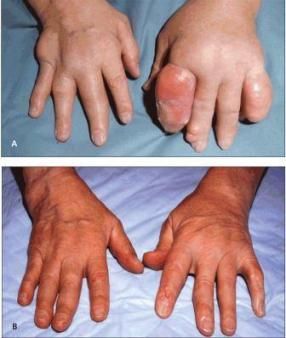- Clinical Technology
- Adult Immunization
- Hepatology
- Pediatric Immunization
- Screening
- Psychiatry
- Allergy
- Women's Health
- Cardiology
- Pediatrics
- Dermatology
- Endocrinology
- Pain Management
- Gastroenterology
- Infectious Disease
- Obesity Medicine
- Rheumatology
- Nephrology
- Neurology
- Pulmonology
Gout Diagnosis: 4 Common Misconceptions
A definitive gout diagnosis is based on demonstration of monosodium urate crystals on aspiration of an affected joint or tophus.

Myth #1. Gout is caused by diet.
Hyperuricemia results from the overproduction and/or underexcretion of uric acid, which leads to signs and symptoms of gout in only a third of persons with hyperuricemia. Hyperuricemia can have numerous causes other than dietary indiscretion.1
Overproduction of uric acid may be the result of:
• Hereditary enzymatic defects
• Vigorous muscle exertion causing excessive turnover of ATP
• Tumors
• Chemotherapy
Underexcretion of uric acid can be a consequence of:
• Genetic disorders (eg, Down syndrome, polycystic kidney disease)
• Diminished renal function from numerous causes, including dehydration and starvation
• Medications including low-dose aspirin, niacin, and thiazide diuretics
• Lead nephropathy
Myth #2. Gout is defined as the presence of high serum urate levels in a patient with joint pain.
As noted, the presence of hyperuricemia with joint pain does not necessarily mean that the patient has gout. The diagnostic gold standard is the presence of monosodium urate crystals seen in aspirated joint fluid.2
Myth #3. Response to colchicine confirms the diagnosis of gout.
Response to colchicine is not in itself an accurate indicator of the presence of gout, because patients with other conditions (psoriatic arthritis, pseudogout, and Behet arthritis) also respond favorably to this medication.3-6
Myth #4. Joint aspiration is not needed to make a definitive diagnosis of gout.
Even when clinical indicators strongly suggest the presence of gout, a definitive diagnosis is based on aspiration of a joint or the presence of tophi.7 All current guidelines agree that the demonstration of monosodium urate (MSU) crystals on joint or tophus aspiration constitutes a definitive diagnosis of gout. The most recent recommendation from the European Union League Against Rheumatism (EULAR) rates identification of MSU crystals in joint fluid at least 10 times higher than any other diagnostic indicator.8
(Photographs courtesy of Peter A. Simkin, MD)
References:
1. Schlesinger N. Diagnosis of gout: clinical, laboratory, and radiologic findings Am J Manag Care. 2005;11:S443-S450.
2. McCarty DJ, Hollander JL. Identification of urate crystals in gouty synovial fluid. Ann Intern Med. 1961;54:452-460.
3. Wallace SL, Robinson H, Masi AT, et al. Preliminary criteria for the classification of the acute arthritis of primary gout. Arthritis Rheum. 1977;20:895-900.
4. Seideman P, Fjellner B, Johannesson A. Psoriatic arthritis treated with oral colchicine. J Rheumatol. 1987;14:777-779.
5. German DC, Holmes EW. Gout and hyperuricemia: diagnosis and management. Hosp Pract (Off Ed). 1986;21:119-126,131-132.
6. Yurdakul S, Mat C, Tzn Y, et al. A double-blind trial of colchicine in Behet’s syndrome. Arthritis Rheum. 2001;44:2686-2692.
7. Lally EV, Zimmerman B, Ho G Jr, Kaplan SR. Urate-mediated inflammation in nodal arthritis: clinical and roentgenographic correlations. Arthritis Rheum. 1989;32:86-90.
8. Zhang W, Doherty M, Pascual E, et al; EULAR Standing Committee for International Clinical Studies Including Therapeutics. EULAR evidence based recommendations for gout. Part I: diagnosis. Report of a task force of the Standing Committee for International Clinical Studies Including Therapeutics (ESCISIT). Ann Rheum Dis. 2006;65:1301-1311.
